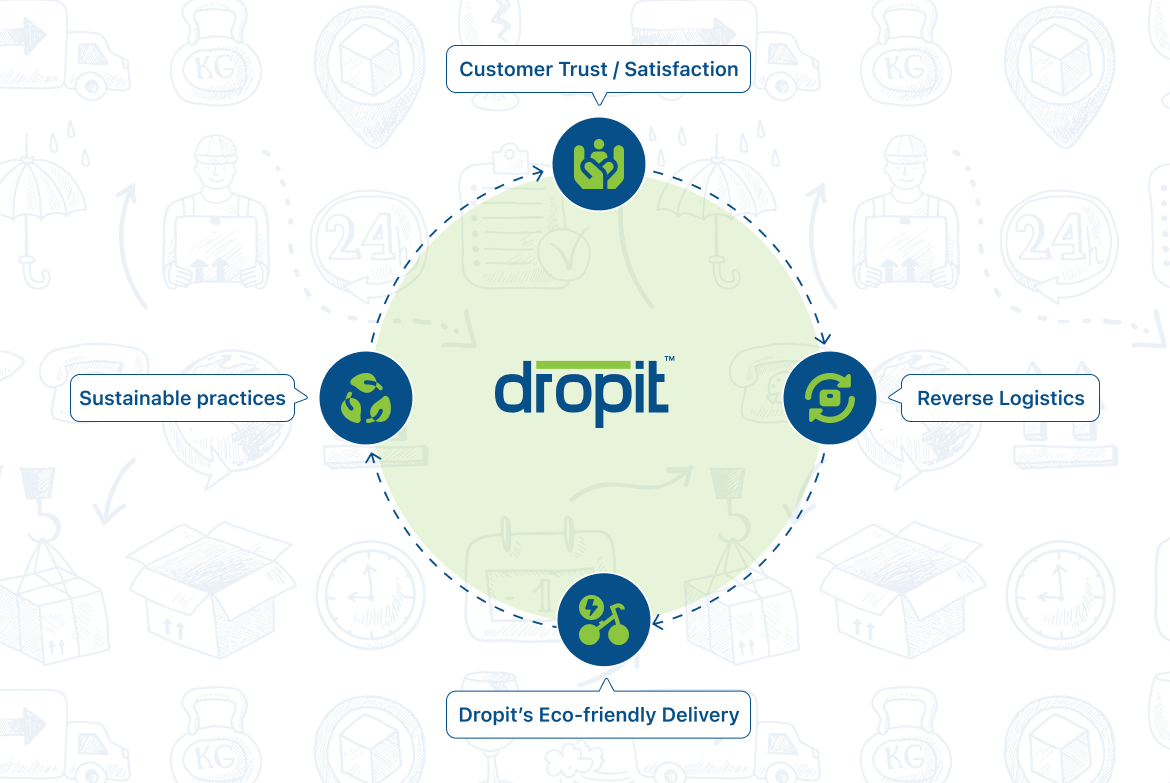In an era where sustainability isn’t a choice but a necessity, businesses must rethink not just how products are delivered but what happens after. As the demand for rapid eCommerce grows, so does waste, packaging pollution, and inefficiencies in returns.
Enter the circular economy, a model where resources are reused, recycled, and reintegrated — minimizing waste and maximizing value. And at the center of this transformation in urban logistics is Dropit, an EV-powered hyperlocal delivery platform revolutionizing reverse logistics and sustainable last-mile practices.
1. What is the Circular Economy and Why Does It Matter?
The circular economy is a shift from the traditional “take-make-dispose” linear model. Instead of creating waste, materials are:
- Reused
- Recycled
- Returned into the system
For logistics and commerce, this means smarter returns, packaging reuse, and asset recovery.
2. Reverse Logistics: The Missing Piece in Sustainable Commerce
While most brands focus on shipping out products, reverse logistics—the flow of goods back to the seller—is often inefficient and carbon-heavy.
Challenges include:
- Multiple failed pickup attempts
- High fuel consumption for returns
- Discarded or non-recycled packaging
- Delayed restocking or refurbishing
📦 Dropit bridges this gap, enabling a reverse logistics model that is both eco-friendly and economically viable.
3. Dropit’s Reverse Logistics Model: Smart, Seamless & Sustainable
Dropit integrates returns and pickups directly into its daily delivery routes using electric cargo bikes.
Its reverse logistics model includes:
- Pickup of returned goods at customer doorstep
- Collection of reusable packaging
- Routing returns to local stores or micro-hubs
- Real-time status updates via the Dropit app
🔁 This enables businesses to recirculate products faster, lowering inventory waste, energy use, and emissions.
4. Reducing Waste Through Packaging Recovery
E-commerce packaging is a massive source of waste—cardboard, bubble wrap, plastic—often used once and discarded.
Dropit enables:
- Collection of used boxes, mailers, or reusable containers
- Sorting at micro-fulfillment centers for reuse or recycling
- Partnerships with brands offering reusable packaging
♻️ This simple loop reduces landfill waste and boosts packaging ROI.
5. Optimizing Delivery Loops With AI and Data
Sustainability is only scalable with intelligent planning. Dropit uses AI-powered logistics tools to:
- Batch returns and deliveries on the same route
- Minimize detours and backtracking
- Assign riders optimized loops based on volume and proximity
- Adapt routes in real-time for new return requests
📊 This means fewer miles, fewer vehicles, and maximum efficiency.
6. Localized Logistics = Faster Circular Flows
Unlike traditional returns that go back to central warehouses, Dropit’s model:
- Returns products to local retail outlets or dark stores
- Enables faster restocking, repairs, or reuse
- Minimizes emissions by avoiding long-haul return trips
🛍️ This “hyperlocal circularity” is ideal for cities where speed and sustainability matter equally.
7. Brands Get ESG Wins Through Dropit
Dropit helps brands meet their Environmental, Social, and Governance (ESG) goals by:
- Reducing Scope 3 emissions (from downstream transport)
- Offering sustainable returns to eco-conscious customers
- Enabling data reporting on emissions saved and items recovered
- Supporting recommerce, repair, and reuse models
🌍 Partnering with Dropit means brands can operate responsibly without compromising convenience.
8. Empowering Green Jobs in the Reverse Supply Chain
Dropit’s model also creates green employment opportunities for youth in cities. Riders are trained not just to deliver, but to:
- Handle reverse pickups
- Sort packaging and reusable materials
- Educate customers on eco-friendly habits
💼 This strengthens the human layer of circular logistics, building environmental awareness at the street level.
9. Circular Delivery for the Subscription Economy
As subscriptions grow in categories like:
- Meal kits
- Personal care
- Fashion rental
- Electronics leasing
The need for frequent returns and pickup loops increases.
Dropit’s recurring reverse logistics is ideal for this model, with:
- Weekly/monthly pickup schedules
- Product swaps
- Container return and reuse
📦 Dropit turns every delivery into a two-way value cycle.
10. Closing the Loop Literally
The end goal? A fully circular logistics model where:
- Every item delivered has a planned return route
- Packaging is reused or responsibly recycled
- Products are recirculated into the system quickly
- Urban logistics supports net-zero cities
Dropit is building that model — one return, one EV cycle, one smart route at a time.
Conclusion: From Waste to Worth — Dropit’s Circular Advantage
Modern logistics must do more than move products; it must move systems toward sustainability. Dropit’s integration of reverse logistics, packaging reuse, and localized delivery demonstrates how circular practices aren’t just idealistic — they’re operational, scalable, and profitable.
Dropit turns sustainability into speed, and returns into returns-on-investment — proving that green logistics is the smartest logistics of all.
Ready to make your delivery ecosystem circular?
Partner with Dropit for eco-smart returns, zero-emission delivery, and urban logistics that give back to the planet.
👉 Get started with Dropit or download the Dropit App to schedule pickups, returns, and deliveries.
